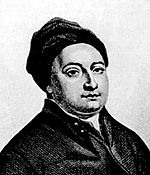William Cheselden facts for kids
Quick facts for kids
William Cheselden
|
|
|---|---|

William Cheselden
|
|
| Born | 19 October 1688 Somerby, Leicestershire
|
| Died | 10 April 1752 (aged 63) |
| Nationality | English |
| Known for | lithotomy |
| Scientific career | |
| Fields | surgery |
| Institutions | St George's Hospital |
| Influences | William Cowper |
| Influenced | Alexander Monro Samuel Sharp |
William Cheselden (born October 19, 1688 – died April 10, 1752) was an important English surgeon and teacher. He taught about anatomy (the study of the body's structure) and surgery (medical operations). Cheselden helped make surgery a respected scientific medical field. His ideas also changed medical practices in places like China and Japan in the 1800s, thanks to a medical missionary named Benjamin Hobson.
Contents
Who Was William Cheselden?
William Cheselden was born in Somerby, Leicestershire, England. He began studying anatomy in London in 1710. His teacher was William Cowper. In the same year, he became a member of the London Company of Barber-Surgeons. This group was for people who cut hair and also performed small medical procedures.
Becoming a Royal Society Member
In 1712, Cheselden was chosen as a Fellow of the Royal Society. This is a very old and famous group for scientists. The next year, he published a book called Anatomy of the Human Body. This book became very popular. It was a key study guide for students for many years. It was special because it was written in English, not Latin, which was the usual language for medical books back then.
Cheselden's Work in Hospitals
In 1718, Cheselden started working at St Thomas' Hospital in London. He became a full surgeon there in 1719 or 1720. He became very good at removing bladder stones, which are hard lumps that can form in the bladder. He made the survival rates for this surgery much better.
Later, he worked at Westminster Infirmary and became the surgeon for Queen Caroline. He also improved eye surgery. He created new ways to remove cataracts, which are cloudy areas in the eye's lens that can cause blurry vision. When St George's Hospital started in 1733, Cheselden was chosen as a surgeon there.
In 1733, he published another important book called Osteographia or the Anatomy of Bones. This was the first complete and correct description of the human skeleton.
Later Life and Legacy
Cheselden left St Thomas' Hospital in 1738. He then moved to the Chelsea Hospital. In 1744, he became the Warden of the Company of Barber-Surgeons. He played a big part in separating surgeons from barbers. This led to the creation of the independent Company of Surgeons in 1745. This organization later became the famous Royal College of Surgeons of England.
William Cheselden died in Bath in 1752.
Helping People See Again
One of Cheselden's most famous achievements happened in 1728. He performed a surgery that helped a 13-year-old boy, who had been blind since birth, to see. This was the first known case of someone fully recovering their sight.
The Boy's Experience
The boy's name was Daniel Dolins. Even though he was young, he had trouble understanding what he saw at first. Cheselden wrote about it:
When he first saw, he thought everything touched his eyes, just like he felt things with his skin. He liked smooth and regular objects, but he couldn't tell their shape. He didn't know one thing from another, no matter how different they were. But when someone told him what things were (things he knew by touch), he would carefully look so he could recognize them later.
A philosopher named George Berkeley thought this case proved his ideas about how we learn to see. Sadly, Daniel Dolins was never able to see well enough to read. There is no proof that the surgery helped his vision much before he died at age 30.
Cheselden's Surgical Innovations
Cheselden is well-known for inventing a new way to remove bladder stones. This method was called the lateral lithotomy. He first performed it in 1727. This surgery was very quick, taking only minutes instead of hours. It also had a low death rate, around 50%, which was very good for that time. Before this, in 1723, Cheselden had also developed another method, which he wrote about in his book A Treatise on the High Operation for the Stone.
He also made big improvements in eye surgery. In 1728, he described a procedure called iridectomy. This operation created an artificial pupil to treat certain types of blindness. Cheselden also explained the role of saliva (spit) in digestion (how the body breaks down food). He was friends with famous people like Sir Isaac Newton and the poet Alexander Pope.
Images for kids
See also
In Spanish: William Cheselden para niños



